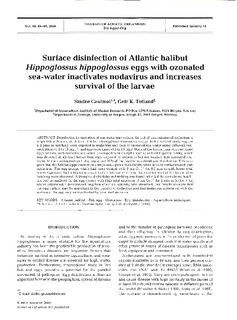Surface disinfection of Atlantic halibut Hippoglossus hippoglossus eggs with ozonated sea-water inactivates nodavirus and increases survival of the larvae
Journal article, Peer reviewed
Permanent lenke
http://hdl.handle.net/11250/107935Utgivelsesdato
2000-01-14Metadata
Vis full innførselSamlinger
- Articles [3012]
Originalversjon
http://dx.doi.org/10.3354/dao039089Sammendrag
Disinfection by ozonation of sea-water may reduce the risk of transmission of nodavirus, a major fish pathogen, via Atlantic halibut Hippoglossus hippoglossus eggs. In the present study, eggs at 4 d prior to hatching were exposed to nodavirus and then to ozonated sea-water using different concentrations (0.3 to 10 mg l(-1)) and exposure times (0.5 to 10 min). None of the larvae from virus-exposed eggs washed with ozonated sea-water developed viral encephalopathy and retinopathy (VER), which was detected in all dead larvae from eggs exposed to nodavirus but not washed with ozonated seawater. In the non-treated control group about 20% of the dead larvae developed the disease. This suggests that the halibut eggs taken from a large-scale production facility were already contaminated with nodavirus. The egg groups which had been treated with 4 mg O-3 l(-1) for 0.5 min or with lower total ozone exposures had a higher survival and no adverse effects on the development of the larvae after hatching were observed. Although a slight delay in hatching was found, after 2 d the cumulative hatching had normalised. In the egg groups with high total exposure (4 mg O-3 l(-1) for 1 min or higher total ozone exposures) a pronounced negative effect on hatching was observed. Our results indicate that the egg surface may be important in the transfer of nodavirus and that nodavirus associated with the surface of the egg may be inactivated by ozonated sea-water.
